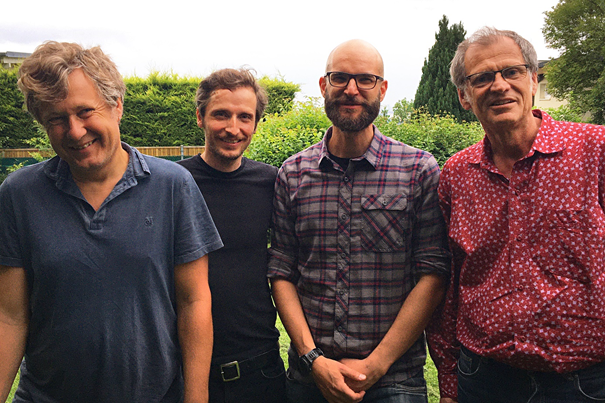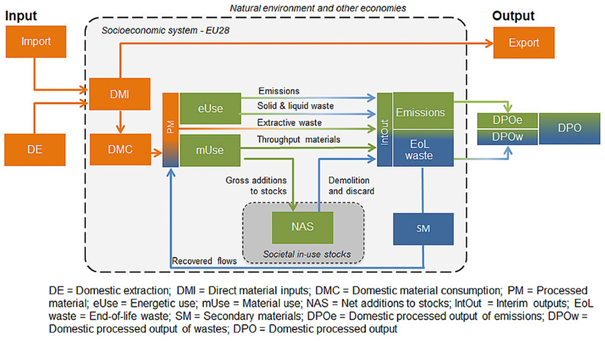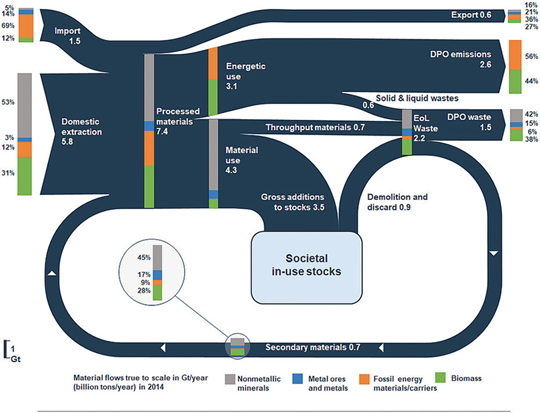This blog post is part of a series on the 2019 Graedel Prize Winners.
Read the other blog post here: Mapping urban material flows with freight data.

From left to right: Fridolin Krausmann, Andreas Mayer, Dominik Wiedenhofer, Willi Haas (not shown: co-Authors Philip Nuss and Gian Andrea Blengini)
The current COVID19 pandemic clearly illustrates the close connection and many pitfalls in the science-policy interface. It also evidences how important it is to have solid and reliable data supporting scientific advice and how unambiguous communication, including uncertainties, is becoming ever more relevant.
Between 2011 and 2014, the European Commission put forward several strategies towards a more sustainable use of natural resources. After some back and forth around the contents of CE legislation between ambitions of the old commission versus plans of the new one, The Circular Economy Action Plan (2018) has been launched). It embraces the entire life-cycle of products, from design to consumption and recycling and aims to benefit job creation, decouple economic growth from resource use and reduce greenhouse gas emissions and environmental footprints. It is being positioned as a transformative strategy across all sectors, which shall contribute to progress towards sustainability. The Circular Economy Action plan is also increasingly being discussed as a building block of the European Green New Deal. Thus, it is highly relevant to monitor if the CE can also deliver on these high expectations.
In preparation of the Commissions CE strategy, a public officer of the European Commission took notice of an article of my co-author Willi Haas on an assessment of the circularity of the European Union and the global economy in the Journal of Industrial Ecology (Haas et al. 2015). He was asked by the Joint Research Center to develop a monitoring framework building on Eurostat data and therefore making the results more acceptable to European policy-makers. Willi invited me to contribute to this study, and so I got involved in the topic of the Circular Economy. Last but not least, I also got the chance to write the final paper of my PhD thesis.
Willi’s original framework was built upon global Material Flow Analysis to account for material and energy use into the global socio-economic system, and modelled/traced the uses, demolitions, discards and re-use/recycling of these resource flows. For this current paper (Mayer et al. 2019), we expanded the framework and systematically and thermodynamically consistently linked material and energy use, waste statistics and primary as well as secondary materials through the EU’s socio-economic system (Figure 1). We built upon a socio-metabolic systems approach (Haberl et al. 2019) and based our assessment as far as possible on statistical data from the official environmental reporting system of the EU. We systematically mass‐balanced economy-wide material flow accounts, covering biomass, non-metallic minerals, ores and metals, as well as fossil energy carriers, with waste statistics and recycling flows reported in Eurostat’s statistical sources.

Figure 1: Framework, indicators and methodological approach for the economy-wide CE assessment (Source, details and description see Mayer et al. 2019)
During the empirical phase of our work, we realized that while clearly resource use and waste/emissions are two sides of the same coin, statistical data and offices collecting this information need to improve their communication with each other. These statistics often utilize different definitions and system boundaries, making them partially incompatible. We found that the Circular Economy might be a powerful concept across scientific and policy silos, bringing together very different actors. While we discussed a necessary improvement of statistical reporting in the end of our paper, only recently, Eurostat has integrated a full set of indicators and measurements for the Circular Economy in their datasets, building upon our initial framework and indicators.
We are quite happy to see that Eurostat has integrated CE Sankey diagrams (see Figure 2 for our initial CE Sankey for the EU28 economy in 2014) for all EU members in their statistics! We think Sankey diagrams are a specifically powerful representation of the CE. They allow to link circularity with the total scale of resource flows into and out from socio-economic systems, underlining the necessity to decrease the overall scale of resource use towards a truly sustainable Circular Economy. We are also optimistic that a lot of work on harmonization of statistical reporting between member countries, alignment of ew-MFA and waste accounts, as well as improving knowledge about material stocks is currently going on to improve the data base for CE assessments.

Figure 2: Material flows through the EU28 economy in 2014.
However, next to the aforementioned improvements in statistical reporting and monitoring, we also think that a much more systemic transformation of production and consumption is required, in order to actually realize the claimed sustainability benefits of a CE. My colleague and co-author Dominik Wiedenhofer told a very telling anecdote during our work on this paper. During the 2016 ISIE-Conference in Nagoya, Japan, they visited the Toyota factory, which has reached an impressive degree of automatization and optimization in car manufacturing, a highly-technology-intensive process. Dominik, together with Fridolin, also hosts a lecture on sustainable resource use at the Institute of Social Ecology in Vienna, where they every year visit a metals collection and recycling facility in Vienna. There, during a very labor-intensive process, workers are basically equipped with screwdrivers and hammers and dismantle technical appliances to sort out mostly iron, copper and a few other metals, while a lot of the specialty metals and rare earths, or other valuable components, are simply discarded. However, only a very limited part of all metal alloys are ultimately recoverable, most of them which are utilized in very scarce quantities in modern technical appliances. This just shows, how advanced and ingenious modern technology and its design and production has become, while most of materials recovery, management and recycling lags far behind. Combined with the ever-growing volume of products and resources being used, this just shows some of the many barriers towards an actually sustainable Circular Economy.
This brings us back to the beginning of this blog entry – evidence based policy making. Scientific results need to be communicated in a clear and understandable way to create impact. We think, it is crucial to provide macro-systems-level guidance and insights, complementary to product- or materials-oriented insights. We thus developed a set of clear and comparable macro-level indicators, which allow to unambiguously communicate the scale and circularity of total materials, energy and waste flows in an economy. Albeit we did not fully quantify all uncertainty in our work, because this would have necessitated much larger efforts than were funded, we did our best to conduct structured sensitivity analyses and provide a critical discussion on data quality. We also decided to put our assumptions and limitations in the annex and were the first article to receive JIE’s golden standard for data transparency and accessibility.
Last but not least, we want to thank the excellent reviewers of our manuscript, who provided us with a lot of comments and suggestions. I am very glad we took the effort of substantial revisions and were able to considerably improve our initial manuscript. We now hope our paper gets discussed in the JIE community, enhances the debate on the Circular Economy between science and policy and helps to contribute to evidence based policy making.
Andreas Mayer together with Willi Haas, Dominik Wiedenhofer, Fridolin Krausmann, Philip Nuss and Gian Andrea Blengini
References
Haas, W., F. Krausmann, D. Wiedenhofer, and M. Heinz. 2015. How Circular is the Global Economy?: An Assessment of Material Flows, Waste Production, and Recycling in the European Union and the World in 2005. Journal of Industrial Ecology(19): 765–777.
Haberl, H., D. Wiedenhofer, S. Pauliuk, F. Krausmann, D.B. Müller, and M. Fischer-Kowalski. 2019. Contributions of sociometabolic research to sustainability science. Nature Sustainability 2(3): 173.
Mayer, A., W. Haas, D. Wiedenhofer, F. Krausmann, P. Nuss, and G.A. Blengini. 2019. Measuring Progress towards a Circular Economy: A Monitoring Framework for Economy-wide Material Loop Closing in the EU28. Journal of Industrial Ecology 23(1): 62–76.

